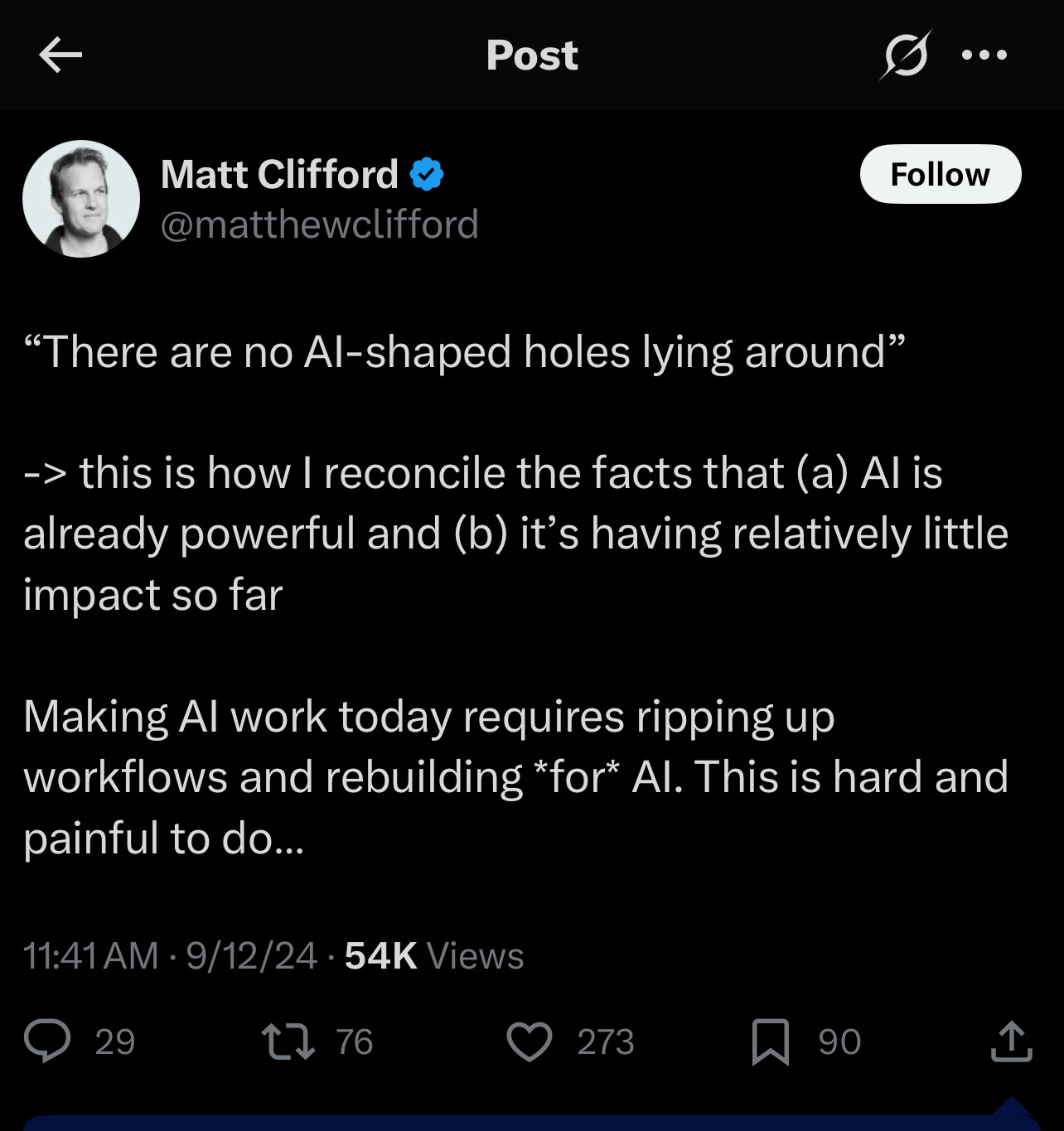I recently had a conversation with an educational leader, and she asked me, “I see so many AI tools out there, how do I know what is good and what is not?” I left that conversation wondering: Is this moment simply about finding the best tool and implementing it?
As Matt Clifford on X pointed out, “There are no AI-shaped holes lying around.” That includes classrooms and schools.
So that makes me wonder:
What opportunities does the introduction of AI enable that were simply not possible before? How can we rethink our systems and better equip teachers, learners, and their parents so that we can expand student learning?
When the calculator came along, math educators had to redefine what it means to “know” and “do” math. Being fluent and efficient at math computations no longer could serve as a proxy for deep and conceptual math understanding. Similarly, the introduction of AI technologies will likely be a catalyst for the humanities and provide an opportunity for us to rethink what it means to be a critical thinker and make connections and have a deep conceptual understanding of language and texts and writing.
AI technologies are exposing that writing an essay or answering multiple-choice questions in response to a text do not, on their own, allow a learner to show deep understanding (e.g., MIT Study Shows Assigning Essays Triggers Student “Brain Rot”). They’re not good proxies for the kinds of learning that we really care about. In fact, because of limitations inherent in our current assessments without AI, many of us have narrowed what we teach to only those things which we can assess, and so we’re often teaching things that feel like insufficient substitutes for deep learning in the humanities.
By way of a more comprehensive analogy, let me further explain the potential power of AI technologies.
Prior to the 18th century, the Western world built bridges using stone and mortar. Bridge design, engineering, and construction improved over time. As engineering knowledge and construction skills increased, engineers perfected how to develop and work with stone and mortar to build complex and long lasting bridges, but there were inherent limits in the materials preventing construction of many bridges that we take for granted today.
In the 18th and 19th centuries, developments of new iron working technologies provided bridge builders with iron girders, trusses, fasteners, and similar innovations. Access to these new technologies completely disrupted bridge building engineering practices (i.e., how long a bridge span can be; how much weight it can carry; how long it will last; the maintenance procedures to maintain the bridge).


While there were still some aspects of building stone and mortar bridges that could apply to building bridges with iron, most of the previous engineering practices that relied on the known standards were now dramatically upended by the new technology.
In education, we’ve been building bridges with stone and mortar and have come to accept the limitations. Now we have AI technologies and tools.
One path we can take is to tack on some iron pieces here and there to our existing stone bridges and call it improved. But look what we get.
Similar to how an iron bridge can span two distant lands that were not able to be connected before or support more weight, allowing for new modes of transportation that couldn’t have crossed stone bridges, what new or improved learning is possible if we redesign our systems and practices? How can these technologies enable changes that we have always wanted to make but we couldn’t before because of limitations?
And to be clear, even with all the changes, we’re still building bridges! This isn’t about using airplanes or teleporting people from one side of the water to the other.
What does that mean? What might be AI’s impact on education?
First, I believe that AI’s biggest impact on education will happen in the background—in the structure. And while this will then enable new and potentially revolutionary changes, I think the vast amount of AI interaction and impact will happen outside of the view of most of our learners.
Related to this, the experience of crossing an iron bridge is presumably very similar to crossing a stone bridge, and similarly, AI’s use in a classroom might not feel that disruptive at least at first to learners. In fact, many of our learners might have limited interaction with AI directly.
Lastly, AI cannot and should not replace teachers—quite the opposite. The yet to be realized promise of AI technologies is that it can enhance what teachers, learners, and their parents are able to do. It can solve previously impossible problems and enable better, sturdier, more reliable ways of getting from problem to solution or from not knowing to understanding.
What do these structural changes look like in practice?
At Learning Tapestry, one way we’re taking this on is starting with how we expect children to build knowledge. With AI technologies we can produce high quality, knowledge-rich content for children quickly. We can create an effectively infinite amount of unique, accurate, and accessible content for children that has never before been available—an “infinite library.”
We are also developing Wonderwood, a knowledge-building app for curious kids. With Wonderwood, children access a universe of knowledge. From animals to chemistry and the arts and everywhere in between, children can use the app to pursue their own interests independently to learn about topics they are curious about. Children can also navigate to connected topics to build their knowledge further. Parents who want to support learning at home and teachers who want to supplement curricula at school can provide children with easy access to knowledge. The app can also be an entry point for children to access more complex knowledge and ideas displayed in museums and other cultural institutions.
But why start with knowledge? First of all, knowledge is essential for reading, but its importance is often overlooked.
Many historical inequities have resulted from individuals and groups being cut off from knowledge and literacy. Zaretta Hammond labeled it a type of “cognitive redlining.”
Unlike speaking for most individuals, the act of reading the words on a page must be explicitly taught and learned. Learning to decode words requires systematic phonics instruction. However, decoding is only a part of learning to read. Understanding what words mean requires knowledge of the world. Without knowledge, texts lack meaning.
Secondly, children are not getting enough access to knowledge. Schools continue to cut time for science and social studies instruction and at home video games and other non-knowledge building activities steal children’s time and attention.
Without Wonderwood, knowledge has to be carefully curated by a teacher or parent. As an English language arts teacher, I was the source of knowledge for my students and it was an impossible task.
I had to decide what knowledge to include and exclude.
I spent hours trying to become an expert on each topic.
I had to spend a bunch of my instructional time trying to motivate the students who were not interested in the topics I picked.
I also hoped that my students had all the background knowledge they needed for the various topics I chose, but I rarely knew if they did or didn’t.
I would try to add books in my classroom library that could help, but I had to find them and buy them, so my options were limited.
I ended up with many missed opportunities as a teacher.
If I was lucky, I landed on a topic or idea that might excite them, but if they wanted to learn more, I had very limited resources to help them expand their learning. I also had no safe way to provide knowledge on demand to my students to help them get more info about what we were learning in class. Most were left to learn only about topics and ideas that I picked for them even if they wanted or needed to know more.
Now with AI technologies, I have the potential to solve those problems.
With Wonderwood, I would no longer need to be the sole source of knowledge. Now, as we’re learning as a class, I can also guide my students in how to be and stay curious about the world in relation to what we’re learning and let them explore independently.
For example, if first graders are reading books and learning about plants as a class, Wonderwood can help those learners independently understand what they are learning as a whole class. Children can do this at home, during a literacy center, or in an afterschool program. It doesn’t take the place of the teacher or learning in class, but it enhances it. It expands learning beyond the classroom walls.
The first graders can access bite-sized read-aloud texts about different types of plants or explore the ways in which plants grow. Then, as Wonderwood recommends a next text, those first graders can make connections from plants to photosynthesis to sunlight and then sunspots to grow their knowledge and extend their learning.



Children benefit from having agency to choose and pursue topics and ideas that interest them and/or they want to know more about related to what they are learning with others.
Without access to these kinds of resources, children move on without ever knowing, creating a knowledge debt that grows exponentially over time.
But to make this happen, I have to rethink the way I’ve approached building knowledge. I can’t build the same kind of bridge and throw in some AI tools. I can’t keep operating in the same way I did before.
This is just one example of how AI can lead us to rethink how we teach and assess learners. We are working on these AI ideas and more at Learning Tapestry. We are working with education organizations to understand problems in education and figure out whether and then how technology, specifically AI, can provide a real solution to those problems. I’m excited to see what new kinds of bridges we can build!
A secret worth knowing: AI’s real power in education lies not in flashy tools, but in reshaping how we teach and learn, quietly expanding access to knowledge.
A question worth pursuing: How might we redesign our educational systems to make the most of AI’s potential without working within the same limitations we’ve accepted for decades? For example, is a single curriculum really best for all learners, or has that been our only option because we lacked the tools to do something different?
Next steps worth taking:
Experiment with retail chatbots like ChatGPT, Claude, Gemini, or PerplexityAI for tasks. Explore what they can do. Where do they help? What are their limits? Consider the personal boundaries you need to set so that you can negotiate the use of AI in collaboration with others confidently and responsibly.
As you pursue AI innovation, prioritize the social and human side of learning. A scary future is one in which everyone learns alone in isolation. How can we create more individualized instruction while still embracing moments for sharing, collaboration, and social ideation? This is especially important in English language arts as making sense of complex texts may start independently, but deep understanding grows through conversations with others. We socially construct meaning as we share and challenge ideas, values, and norms in response to texts.
Reflect on where your teaching or learning practice relies on “stone bridges.” Consider what changes AI technologies may not make possible, and start a conversation with friends or colleagues about rethinking those structures.
Learn more about Wonderwood and download it for your elementary-aged kids.
Share this post with someone who is hesitant to explore or experiment with AI.






